Related Research Articles

A cereal is a grass cultivated for its edible grain. Cereals are the world's largest crops, and are therefore staple foods. They include rice, wheat, rye, oats, barley, millet, and maize. Edible grains from other plant families, such as buckwheat and quinoa, are pseudocereals. Most cereals are annuals, producing one crop from each planting, though rice is sometimes grown as a perennial. Winter varieties are hardy enough to be planted in the autumn, becoming dormant in the winter, and harvested in spring or early summer; spring varieties are planted in spring and harvested in late summer. The term cereal is derived from the name of the Roman goddess of grain crops and fertility, Ceres.

The oat, sometimes called the common oat, is a species of cereal grain grown for its seed, which is known by the same name. Oats appear to have been domesticated as a secondary crop, as their seeds resembled those of other cereals closely enough for them to be included by early cultivators. Oats tolerate cold winters less well than cereals such as wheat, barley, and rye, but need less summer heat and more rain, making them important in areas such as Northwest Europe that have cool wet summers. They can tolerate low-nutrient and acid soils. Oats grow thickly and vigorously, allowing them to outcompete many weeds, and compared to other cereals are relatively free from diseases.

Rye is a grass grown extensively as a grain, a cover crop and a forage crop. It is grown principally in an area from Eastern and Northern Europe into Russia. It is much more tolerant of cold weather and poor soil than other cereals, making it useful in those regions; its vigorous growth suppresses weeds and provides abundant forage for animals early in the year. It is a member of the wheat tribe (Triticeae) which includes the cereals wheat and barley. Rye grain is used for bread, beer, rye whiskey, and animal fodder. In Scandinavia, rye was a staple food in the Middle Ages, and rye crispbread remains a popular food in the region. Europe produces around half of the world's rye; relatively little is traded between countries. A wheat-rye hybrid, triticale, combines the qualities of the two parent crops and is produced in large quantities worldwide. In European folklore, the Roggenwolf is a carnivorous corn demon or Feldgeist.

Porridge is a food made by heating or boiling ground, crushed or chopped starchy plants, typically grain, in milk or water. It is often cooked or served with added flavourings such as sugar, honey, fruit, or syrup to make a sweet cereal, or it can be mixed with spices, meat, or vegetables to make a savoury dish. It is usually served hot in a bowl, depending on its consistency. Oat porridge, or oatmeal, is one of the most common types of porridge. Gruel is a thinner version of porridge and congee is a savoury variation of porridge of Asian origin.

Breakfast cereal is a breakfast food made from processed cereal grains. It is traditionally eaten as part of breakfast, or a snack food, primarily in Western societies.
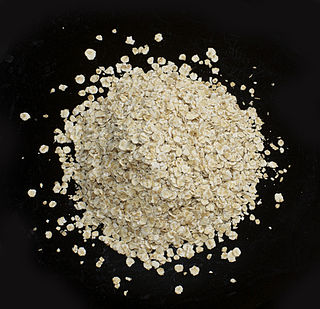
Oatmeal is a preparation of oats that have been de-husked, steamed, and flattened, or a coarse flour of hulled oat grains (groats) that have either been milled (ground), rolled, or steel-cut. Ground oats are also called white oats. Steel-cut oats are known as coarse oatmeal, Irish oatmeal, or pinhead oats. Rolled oats were traditionally thick old-fashioned oats, but can be made thinner or smaller, and may be categorized as quick oatmeal or instant oatmeal depending on the cooking time required, which is determined by the size of the oats and the amount of precooking.

Bran, also known as miller's bran, is the component of a cereal grain consisting of the hard layers - the combined aleurone and pericarp - surrounding the endosperm. Corn (maize) bran also includes the pedicel. Along with the germ, it is an integral part of whole grains, and is often produced as a byproduct of milling in the production of refined grains. Bran is highly nutritious, but is difficult to digest due to its high fiber content; its high fat content also reduces its shelf life as the oils/fats are prone to becoming rancid. As such, it is typically removed from whole grain during the refining process - e.g. in processing wheat grain into white flour, or refining brown rice into white rice.
Agriculture and Agri-Food Canada is the department of the Government of Canada responsible for the federal regulation of agriculture, including policies governing the production, processing, and marketing of all farm, food, and agri-based products. Agriculture in Canada is a shared jurisdiction and the department works with the provinces and territories in the development and delivery of policies and programs.
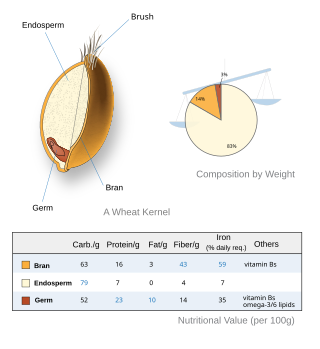
A whole grain is a grain of any cereal and pseudocereal that contains the endosperm, germ, and bran, in contrast to refined grains, which retain only the endosperm.

Rolled oats are a type of lightly processed whole-grain food. They are made from oat groats that have been dehusked and steamed, before being rolled into flat flakes under heavy rollers and then stabilized by being lightly toasted.
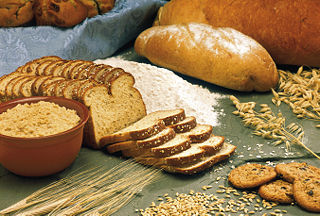
A food group is a collection of foods that share similar nutritional properties or biological classifications. Lists of nutrition guides typically divide foods into food groups, and Recommended Dietary Allowance recommends daily servings of each group for a healthy diet. In the United States for instance, the USDA has described food as being in from 4 to 11 different groups.

Beta-glucans, β-glucans comprise a group of β-D-glucose polysaccharides (glucans) naturally occurring in the cell walls of cereals, bacteria, and fungi, with significantly differing physicochemical properties dependent on source. Typically, β-glucans form a linear backbone with 1–3 β-glycosidic bonds but vary with respect to molecular mass, solubility, viscosity, branching structure, and gelation properties, causing diverse physiological effects in animals.
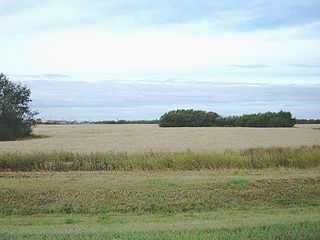
Agriculture in Saskatchewan is the production of various food, feed, or fiber commodities to fulfill domestic and international human and animal sustenance needs. The newest agricultural economy to be developed in renewable biofuel production or agricultural biomass which is marketed as ethanol or biodiesel. Plant cultivation and livestock production have abandoned subsistence agricultural practices in favor of intensive technological farming resulting in cash crops which contribute to the economy of Saskatchewan. The particular commodity produced is dependent upon its particular biogeography or ecozone of Geography of Saskatchewan. Agricultural techniques and activities have evolved over the years. The first nation nomadic hunter-gatherer lifestyle and the early immigrant ox and plow farmer proving up on his quarter section of land in no way resemble the present farmer operating huge amounts of land or livestock with their attendant technological mechanization. Challenges to the future of Saskatchewan agriculture include developing sustainable water management strategies for a cyclical drought prone climate in south western Saskatchewan, updating dryland farming techniques, stabilizing organic definitions or protocols and the decision to grow, or not to grow genetically modified foods. Domestically and internationally, some commodities have faced increased scrutiny from disease and the ensuing marketing issues.

Barley, a member of the grass family, is a major cereal grain grown in temperate climates globally. It was one of the first cultivated grains; it was domesticated in the Fertile Crescent around 9000 BC, giving it nonshattering spikelets and making it much easier to harvest. Its use then spread throughout Eurasia by 2000 BC. Barley prefers relatively low temperatures and well-drained soil to grow. It is relatively tolerant of drought and soil salinity but is less winter-hardy than wheat or rye.
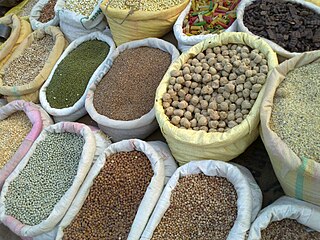
A grain is a small, hard, dry fruit (caryopsis) – with or without an attached hull layer – harvested for human or animal consumption. A grain crop is a grain-producing plant. The two main types of commercial grain crops are cereals and legumes.
The Cereal Research Centre was a research institute established in 1925 based at the University of Manitoba in Winnipeg. It became part of a national network of research centres operated by Agriculture and Agri-Food Canada. Its research led to the development of over two hundred varieties of plant species resistant to pests and blights and producing high yields suitable for cultivation in the Canadian Prairies.

Oat β-glucans are water-soluble β-glucans derived from the endosperm of oat kernels known for their dietary contribution as components of soluble fiber. Due to their property to lower serum total cholesterol and low-density lipoprotein cholesterol, and potentially reduce the risk of cardiovascular diseases, oat β-glucans have been assigned a qualified health claim by the European Food Safety Authority and the US Food and Drug Administration.
Joyce Boye is a former federal food research scientist with Agriculture and Agri-Food Canada with a specialty in value-added food processing, food safety and food quality. She has expertise on plant proteins and their importance in helping to improve human health and nutrition. The Food and Agriculture Organization of the United Nations appointed Boye to be a Special Ambassador for North America for the 2016 International Year of Pulses.
Vernon Douglas Burrows was a research scientist at Agriculture and Agri-Food Canada (AAFC) and an international authority on oat breeding and utilization. He bred and registered 28 varieties of oats, including AC Gehl, the “naked oat,” which is hulless and hairless and therefore easier to process and transport. In 2001 Burrows was appointed as Member of the Order of Canada, and in 2018 he was promoted to Officer of the Order of Canada for his research that has enhanced the production and nutritional value of oat-based foods.
Sylvie Cloutier is a Canadian scientist. She is a specialist in molecular genetics at Agriculture and Agri-Food Canada's Ottawa Research and Development Centre and an adjunct professor at the University of Ottawa. She has co-led two Genome Canada Large Scale Applied Research projects of $11M each and has been involved in over 110 published research papers and made contributions to many books.
References
- 1 2 3 4 5 6 7 "Dr. Nancy Ames". profils-profiles.science.gc.ca. 2019-05-23. Retrieved 2020-03-09.
- 1 2 "Nancy Ames, Ph.D." CropSphere | Sessions on market outlook, research, agronomy. Retrieved 2020-03-09.
- ↑ Canada, Agriculture and Agri-Food Canada;Government of (2013-10-18). "Barley is 'in' when it comes to heart health". www.agr.gc.ca. Retrieved 2020-03-09.
{{cite web}}: CS1 maint: multiple names: authors list (link) - ↑ "Health & Nutrition | GoBarley" . Retrieved 2020-03-09.
- 1 2 Comin, Lauren (2014-01-01). "Cereal Booster: Wheat and barley expert Nancy Ames wants consumers to know the whole story around gluten" (PDF). Grains West. Retrieved 2020-04-29.
- ↑ January 18; says, 2015 at 6:57 am Ernie. "Wheat School: Should Nutrition be Considered When Bringing Forward New Wheat Varieties?". RealAgriculture.com. Retrieved 2020-04-08.
{{cite web}}: CS1 maint: numeric names: authors list (link) - 1 2 "Wheat School: Still Good For You — Research Counters Popular Claims About Wheat's Nutritional Value". RealAgriculture.com. Retrieved 2020-04-08.
- ↑ Canada, Agriculture and Agri-Food Canada;Government of (2018-04-26). "Wheat's Nutritional Value". www.agr.gc.ca. Retrieved 2020-04-28.
{{cite web}}: CS1 maint: multiple names: authors list (link) - 1 2 "SNACK MACHINE – grainswest" . Retrieved 2020-04-08.
- 1 2 3 4 5 "Speakers". www.abic.ca. Retrieved 2020-03-09.
- 1 2 Manitoba, University of (2018-08-09). "Aug 2018: Innovation". Winnipeg Free Press. Retrieved 2020-04-08.
- ↑ "Another step forward for food barley". Top Crop Manager. 2013-02-28. Retrieved 2020-03-09.
- ↑ Canadian Press (2008-05-05). "Scientist hopes to woo manufacturers into making barley products". CBC News. Retrieved 2020-04-29.
- 1 2 "Company Is "Local, Whole Grain And Friendly"". Grainews. 2011-02-28. Retrieved 2020-04-08.
- ↑ "Health Canada gives barley permission to boast about its health benefits". Manitoba Co-operator. 2012-08-10. Retrieved 2020-04-08.
- ↑ "Barley fibre helps lower cholesterol and risk of heart disease | Alberta Barley" . Retrieved 2020-04-08.
- ↑ Hart, Lee (2014-04-14). "Health Claims 101: What does it take for a food product to receive the stamp of approval ?" (PDF). Grain News. Retrieved 2020-04-29.
- ↑ "Nancy Ames Inventions, Patents and Patent Applications - Justia Patents Search". patents.justia.com. Retrieved 2020-03-09.
- ↑ "Canada Invents". Susan Hughes. Retrieved 2020-04-08.
- ↑ "Barley Flour Makes Fantastic Tortillas". Manitoba Co-operator. 2009-12-03. Retrieved 2020-04-08.
- 1 2 "Public lunch promotes instant barley". The Western Producer. 2003-03-27. Retrieved 2020-04-08.
- 1 2 "GoBarley Cookbook: Modern Recipes for an Ancient Grain | GoBarley" . Retrieved 2020-04-08.
- ↑ "Food Day Canada presents Barley - A New Super Food". fooddaycanada.ca. Retrieved 2020-04-28.
- 1 2 "VIDEO: Building a better bagel". The Western Producer. 2016-12-29. Retrieved 2020-04-08.
- ↑ Homegrown: Celebrating the Canadian Foods We Grow, Raise and Produce. ASIN 1770502327.
- ↑ "Food Day Canada presents Barley - A New Super Food". fooddaycanada.ca. Retrieved 2020-04-08.
- ↑ Built On Agriculture | Part 4: Feeding the World , retrieved 2020-04-08
- ↑ Sandi (2014-11-12). "Dr. Ames presents: Does Science Belong On My Plate?". Eat Well. Retrieved 2020-04-08.
- ↑ "Oat sector needs to get doctors to tout benefits". The Western Producer. 2013-12-19. Retrieved 2020-04-08.
- ↑ Nicole (2013-11-07). "Ideal Grain Ingredients: BREEDING WHEAT FOR HEALTH". Canadian Food Business. Retrieved 2020-04-08.
- ↑ "Newground Magazine Spring 2013 Canada". Issuu. Retrieved 2020-04-08.
- 1 2 "Largest Bowl of Oatmeal - world record set by Agriculture and Agri-Food Canada". www.worldrecordacademy.com. Retrieved 2020-03-09.
- ↑ "Artificial stomach enhancing digestive, dietary research at University of Manitoba". CBC News. January 19, 2018. Retrieved April 29, 2020.
- ↑ Canada, Agriculture and Agri-Food Canada;Government of (2016-09-26). "Barley: A top crop from your heart to your gut". www.agr.gc.ca. Retrieved 2020-03-09.
{{cite web}}: CS1 maint: multiple names: authors list (link) - ↑ Wang, Yanan; Ames, Nancy P.; Tun, Hein M.; Tosh, Susan M.; Jones, Peter J.; Khafipour, Ehsan (2016-02-10). "High Molecular Weight Barley β-Glucan Alters Gut Microbiota Toward Reduced Cardiovascular Disease Risk". Frontiers in Microbiology. 7: 129. doi: 10.3389/fmicb.2016.00129 . ISSN 1664-302X. PMC 4748052 . PMID 26904005.
- ↑ Manitoba, University of. "Future Indigenous scientists from across Canada come to campus" . Retrieved 2020-03-09.